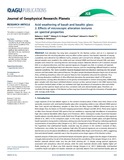Acid weathering of basalt and basaltic glass: 2. Effects of microscopic alteration textures on spectral properties
Metadata
Show full item recordAuthor
Smith, Rebecca J.
Horgan, Briony H. N.
Mann, Paul
Cloutis, Edward A.
Christensen, Philip R.
Date
2017-01-24Citation
Smith, R.J., B.N.H. Horgan, P. Mann, E.A. Cloutis, and P.R. Christensen. "Acid weathering of basalt and basaltic glass: 2. Effects of microscopic alteration textures on spectral properties." Journal of Geophysical Research: Planets 122 (2017): 203-227. DOI:10.1002/2016JE005112.
Abstract
Acid alteration has long been proposed for the Martian surface, and so it is important to understand how the resulting alteration textures affect surface spectra. Two basaltic materials of varying crystallinity were altered in two different H2SO4 solutions (pH 1 and pH 3) for 220 days. The unaltered and altered samples were studied in the visible and near infrared (VNIR) and thermal infrared (TIR), and select samples were chosen for scanning electron microscopy analysis. Materials altered in pH 3 solutions showed little to no physical alteration, and their spectral signatures changed very little. In contrast, all materials altered in pH 1 acid displayed silica-rich alteration textures, and the morphology differed based on starting material crystallinity. The more crystalline material displayed extensive alteration reaching into the sample interiors and had weaker silica spectral features. The glass sample developed alteration layers tens of microns thick, exhibiting amorphous silica-rich spectral features that completely obscured the substrate. Thus, the strong absorption coefficient of silica effectively decreases the penetration depth of TIR spectral measurements, causing silica abundances to be grossly overestimated in remote sensing data. Additionally, glass samples with silica layers exhibited distinct concave up blue spectral slopes in the VNIR. Spectra from the northern lowland plains of Mars are modeled with high abundances of amorphous silica and exhibit concave up blue spectral slopes and are thus consistent with acid altered basaltic glass. Therefore, we conclude that large regions of the Martian surface may have formed through the interaction of basaltic glass with strongly acidic fluids.

